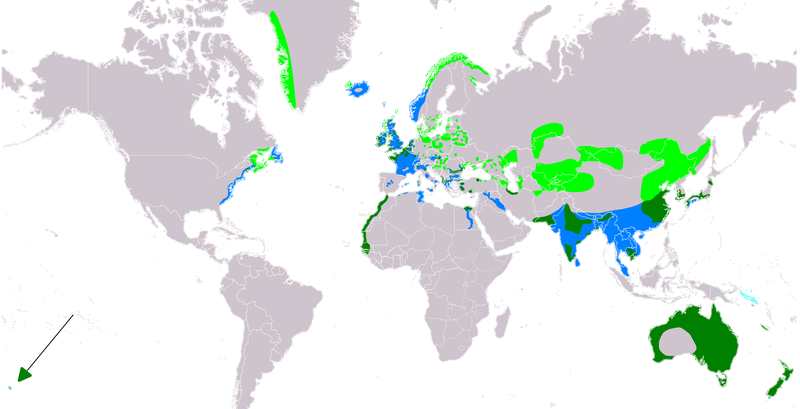Wednesday 26 January 2022
RED BREASTED MERGANSER (Mergus serrator) male at Broadmeadow Estuary, Malahide, Fingal, Co. Dublin, Ireland
Sunday 23 January 2022
EURASIAN TEAL (Anas crecca) at Broadmeadow Estuary, Swords, Fingal, Co. Dublin, Ireland
The small scattered resident population in Ireland and Britain greatly increases from September when northern birds begin to arrive. Having overwintered, they begin to disperse back to their breeding grounds and most have gone by the end of March.
The Engineer, CC BY-SA 3.0 <http://creativecommons.org/licenses/by-sa/3.0/>, via Wikimedia Commons
Wednesday 19 January 2022
Sunday 16 January 2022
HOODED CROW or GREY CROW (Corvus cornix) attempting to remove a Common Periwinkle (Littorina littorea) from its shell at Broadmeadow Estuary, Malahide, Fingal, Co. Dublin, Ireland
Click external link here for detailed species information
Click external link here to see distribution map and to hear calls
The Hooded Crow (Corvus cornix) also known as Grey Crow is a member of the crow family Corvidae which is in the genus Corvus.
Four subspecies are generally recognized. Despite the fact that it is
heavily persecuted, it occurs throughout Western Asia including parts of
the Middle East as well as along the Nile Valley in North Africa. It is
also commonly encountered and has a widespread distribution in Northern, Central and Eastern
Europe. It is resident in Ireland, Isle of Man and Northern Scotland. In the rest of Britain as well as Southwestern and Western Europe, it is replaced by the
closely related Carrion Crow (Corvus corone) from which it was split in
2002 and was recognised as a separate species. Where their breeding ranges overlap, they may
hybridise. Some of the northern populations are migratory and move south for the winter.
Saturday 15 January 2022
COMMON GREENSHANK (Tringa nebularia) at Broadmeadow Estuary, Malahide, Fingal, Co. Dublin, Ireland

Thursday 6 January 2022
YELLOW LEGGED GULL (Larus michahellis) adult and a group of Black Headed Gulls (Chroicocephalus ridibundus) from 07-01-2022 to at least 03-02-2022 at Broadmeadow Estuary, Swords, Fingal, Co. Dublin, Ireland
- Larus michahellis michahellis - breeds in parts of western and southern Europe, as well as the Mediterranean Basin.
- Larus michahellis atlantis - known as Atlantic Gull, breeds on the Atlantic coasts of France, Iberia, Morocco, Canary Islands, Madeira as well as a dark headed form that occurs on the Azores.
Tuesday 4 January 2022
COMMON REDSHANK (Tringa totanus) at Broadmeadow Estuary, Swords, Fingal, Co. Dublin, Ireland

Saturday 1 January 2022
CONTINENTAL CORMORANT (Phalacrocorax carbo subspecies P. c. sinensis) immature on 1st January 2022 at Swords Sailing Club, Broadmeadow Estuary, Malahide, Fingal, Co. Dublin, Ireland
- Broadmeadow Estuary, Swords, 1st winter from 4th to 30th January 2013.
- Broadmeadow Estuary, Swords, 1st winter from 28th January to 16th May 2013, different from above.
- Scotsman Bay, Dunlaoire, adult on 1st February 2014.

Friday 10 September 2021
GARDEN BUMBLEBEE (Bombus hortorum) Broadmeadow Estuary, Swords, Fingal, Co. Dublin, Ireland
Wednesday 8 September 2021
LITTLE EGRET (Egretta garzetta) adult in breeding plumage Broadmeadow Estuary, Swords, Fingal, Co. Dublin, Ireland
Tuesday 17 August 2021
RED UNDERWING MOTH (Catocala nupta) on 17-08-2021 attracted to security light Broadmeadow Estuary, Swords, Fingal, Co. Dublin, Ireland
Wednesday 10 February 2021
Sunday 7 February 2021
LITTLE EGRET (Egretta garzetta) Broadmeadow Estuary, Swords, Fingal, Co. Dublin, Ireland
The Little Egret (Egretta garzetta) is a member of the heron family Ardeidae which includes Bitterns, Egrets and Herons. It is found in the temperate parts of Eurasia and Africa as well as Australia and New Zealand. Over the last 60 years or so this species has greatly expanded its range including recolonising its former breeding areas in Northern Europe, as well as Ireland. It first bred in the Caribbean in the mid 1990’s and is increasingly being recorded along the North American eastern seaboard.
Monday 18 January 2021
EURASIAN BLACKCAP (Sylvia atricapilla) female with a preference for home made muffins over shop bought fat balls, Broadmeadow Estuary, Swords, Fingal, Co. Dublin, Ireland
Sunday 17 January 2021
Saturday 16 January 2021
BLACK HEADED GULL (Chroicocephalus ridibundus) adult winter plumage at Broadmeadow Estuary, Swords, Fingal, Co. Dublin, Ireland
Friday 15 January 2021
BLACK HEADED GULL (Chroicocephalus ridibundus) adult winter plumage, Broadmeadow Estuary, Swords, Fingal, Co. Dublin, Ireland
Thursday 14 January 2021
EURASIAN SISKIN (Spinus spinus) male at Broadmeadow Estuary, Swords, Fingal, Dublin, Ireland
Eurasian Siskin (Spinus spinus) distribution map






























